Samsung is going for a three-pronged attack for its premium TV lineup for 2024. It’s sorted its flagship and step-down TV models into three houses: 8K Neo-QLED, 4K OLED and 4K Neo-QLED. The QN95D fits into the final category, serving as Samsung’s flagship 4K Neo-QLED model.
It’s among a group of rather prestigious colleagues – the S95D and QN900D are its 4K OLED and 8K Neo-QLED counterparts and both are five-star stunners. So can the QN95D score Samsung the hat trick?
Price
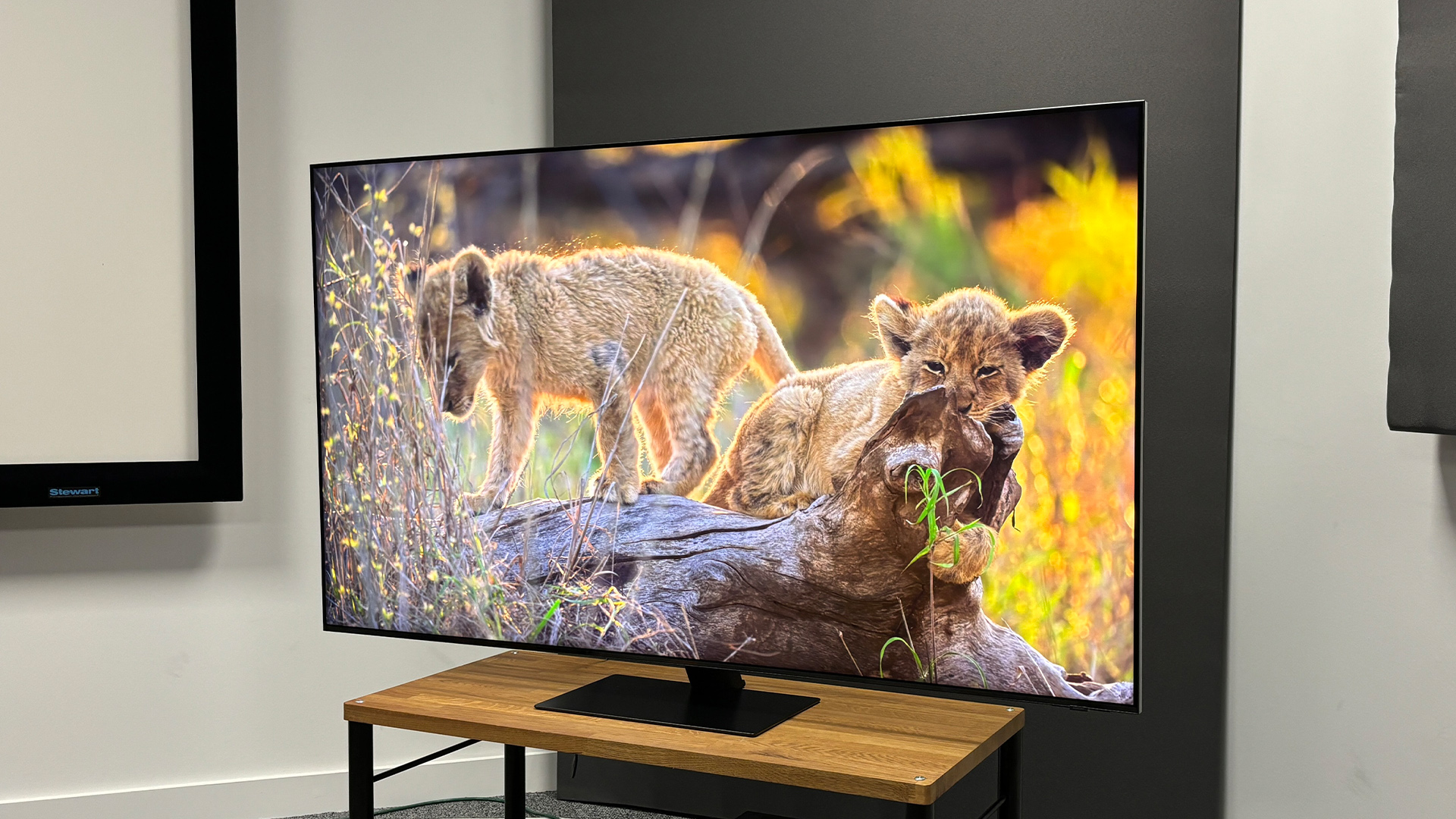
At £3299 (around $4195 / AU$6340), the 65-inch Samsung QN95D (QE65QN95D) is certainly priced as a flagship TV. Should 65 inches be too large or small for you, the QN95D is also available in 55-, 75- and 85-inch sizes, though it is worth pointing out that some specs, most notably the number of dimming zones, vary somewhat at different screen sizes.
While the 65-inch QN95D is undoubtedly pricey, it’s actually a fair bit cheaper than its predecessor, the QN95C. That TV cost £3699 at launch for the 65-inch version, so we’re looking at a reduction of roughly £400 – which isn’t to be sniffed at.
Unfortunately for the QN95D, it’s up against some strong competition, not least from within Samsung itself: the superb S95D QD-OLED is priced at £3599 / $3400 / AU$4999. While they’re not identical in price, it’s a small enough gap that you may be considering the QD-OLED TV as well – we’ll dig into performance comparisons later.
Somewhat surprisingly, the QN95D doesn’t seem to be on sale in the US or Australia, with both markets only going up to the QN90D, which is considered the step-down model here in the UK.
Design
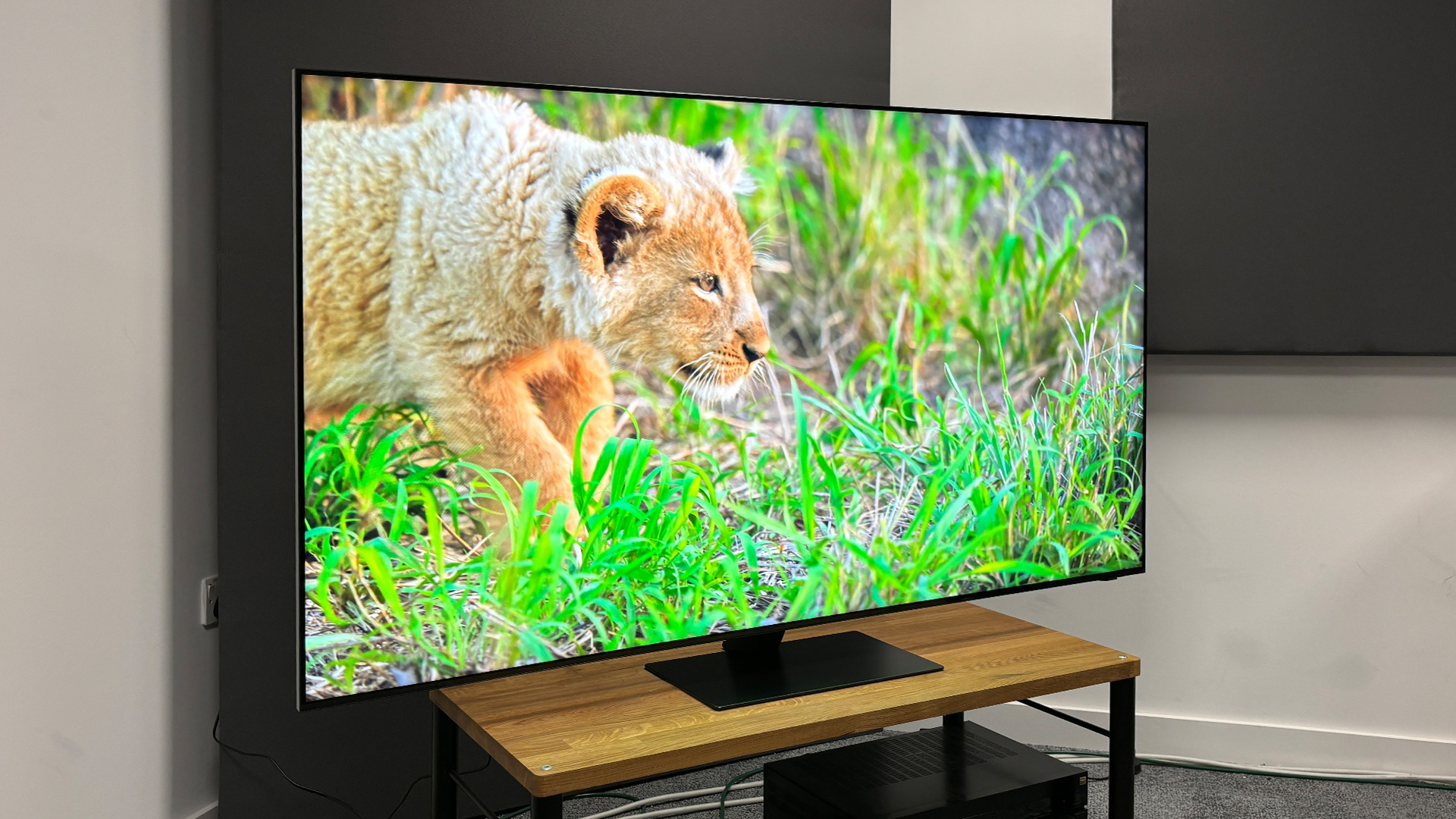
The Samsung QN95D looks practically identical to the QN95C it’s replacing. It features Samsung’s ‘Infinity One’ design, so the bezels around the screen are pleasingly slim and modern-looking, and it has a centrally mounted pedestal that connects to a rectangular metal base plate. While it’s a shame that the stand doesn’t have a swivel function, we’ll take the fact that it will fit on practically any entertainment unit (even a fairly narrow one) as a win. You can, of course, wall mount this TV if you so desire, using its 400 x 400mm standard VESA mounting points.
Samsung QN95D tech specs
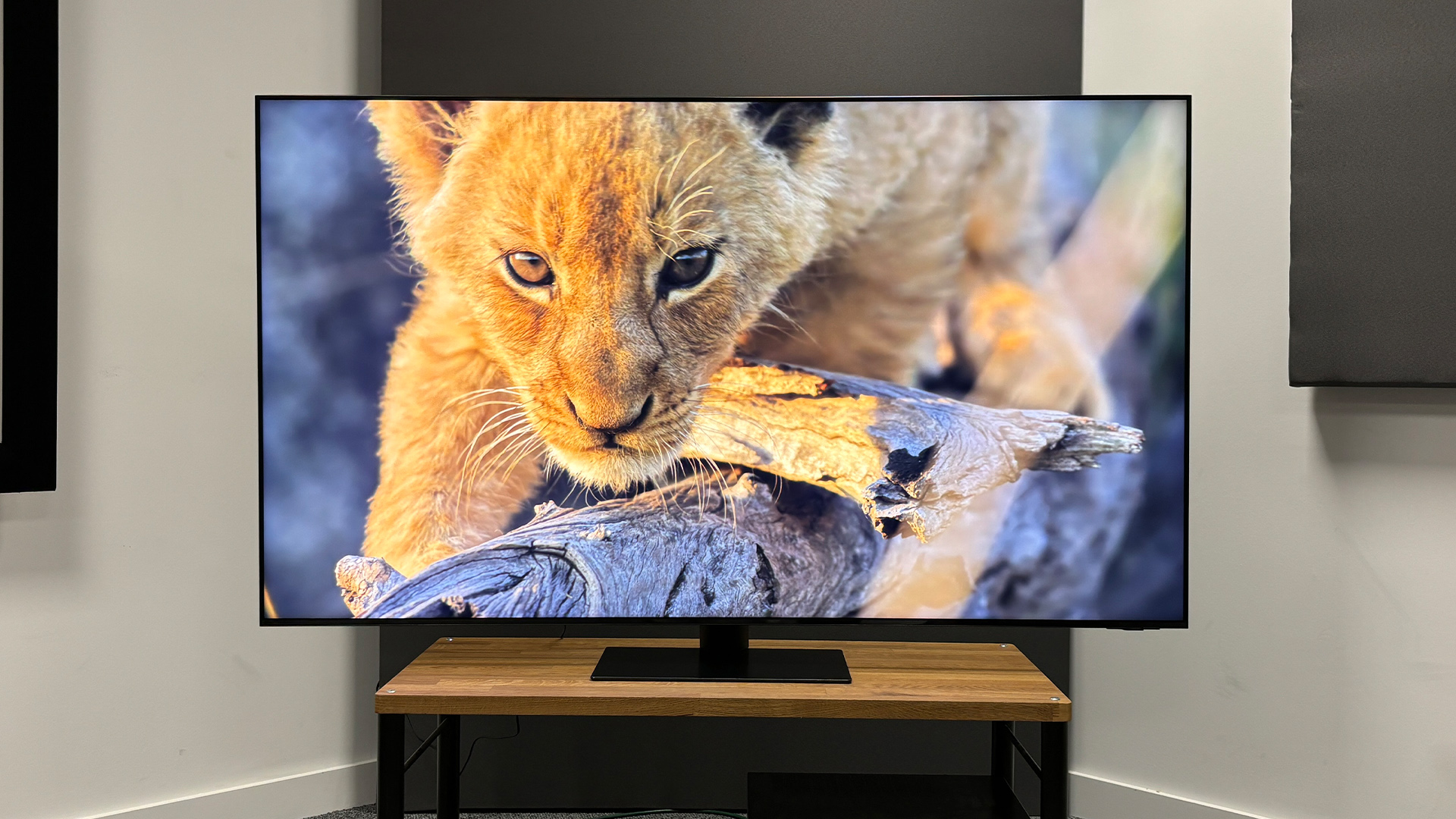
Screen size 65 inches (also available in 75in, 85in)
Type QLED
Backlight Mini LED
Resolution 4K
HDR formats HLG, HDR10, HDR10+
Operating system Tizen
HDMI inputs x 4, 48Gbps HDMI 2.1
Gaming features 4K/120Hz, VRR, ALLM
Input lag 9.8ms (60Hz)
ARC/eARC eARC
Optical output? Yes
Dimensions (hwd, without stand) 83 x 145 x 2cm
While we’d recommend having the front of the TV facing your sofa for the optimal viewing experience, it has to be said that the QN95D also looks quite tidy from the back. It has a ridged finish, with a selection of grooves to hold your cables, helping to prevent the common issue of messy, tangled wires being shoved behind your cabinet. Better yet, the stand features a detachable back plate, which means you can route cables through it for an even tidier arrangement. These cables will be plugging directly into the TV as, unlike the S95D, the QN95D does not feature a One Connect box.
The premium look is rounded out with the slender, metallic-looking edges that give the TV a visual appeal no matter what angle you look at it. The flat rails look suitably premium and the set is much thinner than some other notable Mini LED TVs we’ve seen recently, such as the TCL C845K.
We’ll round things out with the remotes, of which there are two. One is a traditional, button-heavy handset, the other is Samsung’s Solar Cell Remote. The latter is a smart, simplistic and environmentally friendly option that features a non-removable rechargeable battery that (as the name suggests) uses solar energy to charge up – although it can be plugged in via a USB-C cable for a top-up if needed. Both remotes feel quite plasticky in the hand and we much prefer the metal remotes with backlit buttons that we often see bundled with Sony, Panasonic and Philips sets.
Features
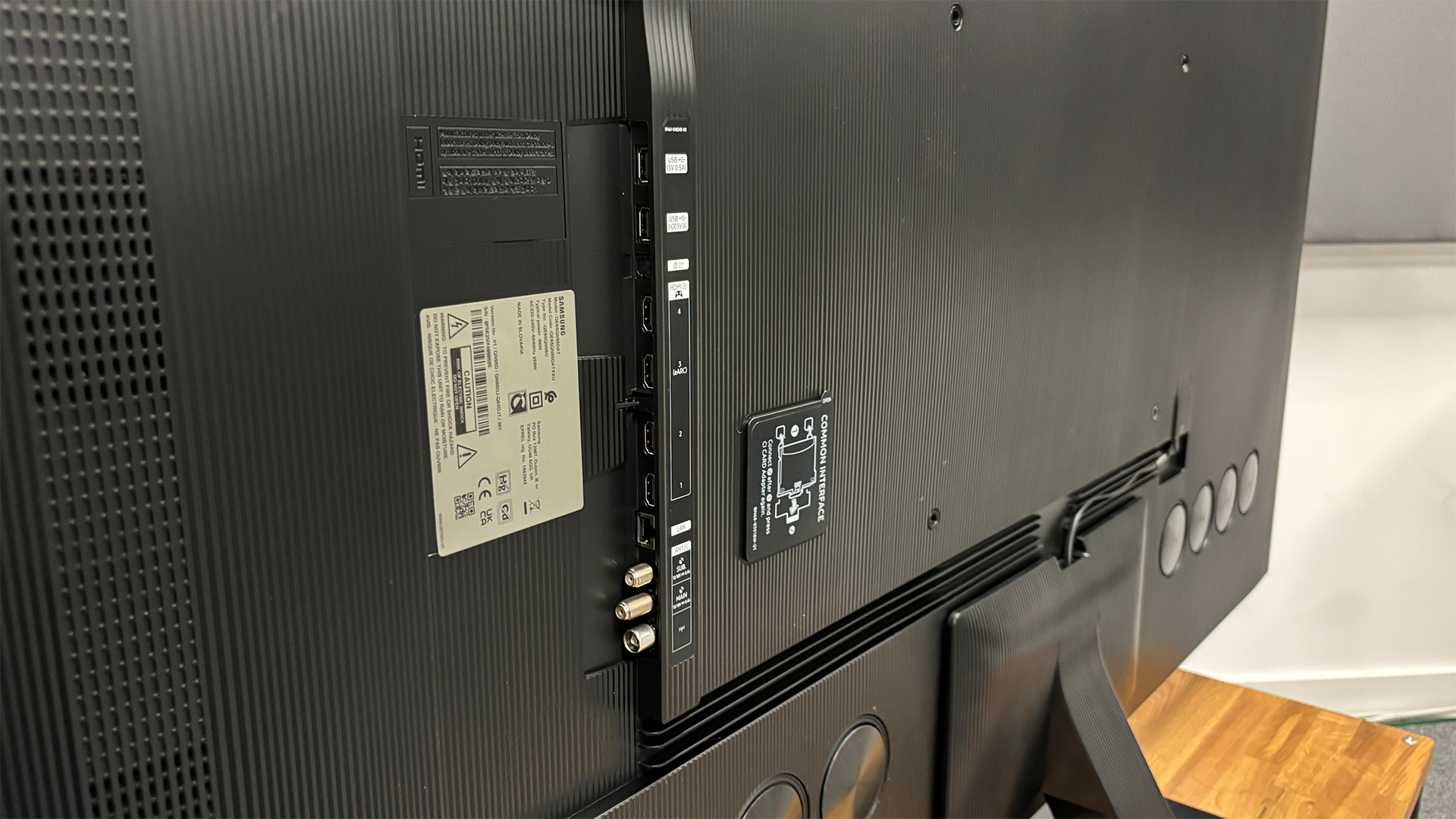
If you’re unfamiliar with Neo QLED and are already rolling your eyes at the prospect of having to remember another screen technology abbreviation, then fret not. This is simply Samsung’s term for combining a Mini LED backlight with Quantum Dots. It’s a 4K VA LCD panel here with 1344 separately controlled zones on the 65-inch model we have before us. Samsung has also included its wide viewing angle technology to ensure that the picture looks consistent across a variety of viewing positions.
Samsung is going heavy on the AI integration this year too, hence the Neo Quantum 4K AI Gen 2 Processor inside, which is shared with the S95D. Alongside playing an integral role in the backlight’s local dimming function, Samsung is also attributing the host of AI-powered features in this TV to its latest processor.
The AI Gen 2 processor has a plentiful resource of over 20 separate neural networks that it can tap into, which play a key role in upscaling standard definition and 1080p content to 4K and provide an enhanced three-dimensional effect to images through the Real Depth Enhancer Pro system. Samsung also includes its Auto HDR remastering feature, which means the TV will attempt to convert SDR content into HDR. It’s not a night and day difference in our experience and purists may prefer to steer clear.
On the subject of high dynamic range, it should come as no surprise to find that the QN95D supports HDR10, HLG and HDR10+. As expected, Dolby Vision has been left out in the cold yet again. Dolby is partially welcomed back when it comes to sound, though, as Dolby Atmos is supported. Samsung’s Q Symphony audio feature, which synchronises the TV’s speakers with those of a compatible Samsung soundbar connected over HDMI eARC, is unsurprisingly also present.
Speaking of HDMI, Samsung features its usual near-flawless gaming specification on the QN95D. We find four HDMI 2.1 sockets on the rear, each of which is capable of handling full 48GB bandwidth signals – meaning 4K/120Hz gaming with VRR and ALLM will work no matter which socket you’re plugged into. This is of course ideal for those who have both of the latest generation consoles and a soundbar or AVR, as they won’t have to compromise on gaming performance if they want to hook up an external audio device.
The QN95D itself features a 4.2.2 channel sound system that’s rated at a claimed 70W of power. Samsung’s AI influence is felt here too, with Active Voice Amplifier Pro and Adaptive Sound Pro features on board. The former brings dialogue forward in the mix, making vocals easier to hear in scenes with lots of competing sound effects, while the latter aims for an ‘as the creator intended approach’, using AI to optimise the sound performance based on the characteristics of your room and the content itself.
Samsung’s smart system is a familiar affair with a few new additions for 2024. The full-screen system could prove slightly overwhelming for some, thanks to the abundance of apps, services and settings – although Samsung sorts them into three categories for entertainment, gaming and lifestyle-related services. App compatibility is mostly solid, but we do notice a couple of omissions.
While all the big hitters such as Netflix, Amazon Prime Video, Apple TV, Disney Plus and Paramount Plus are all there, there are a couple of gaps in the UK-specific streaming services. ITV X and Channel 5 are on board, but our review unit does not have access to the BBC iPlayer or Channel 4 apps. Samsung assures us they will be added soon, but no date has been provided.
Gaming-focused streaming services are on board, though, with Xbox, Amazon Luna, GeForce Now and more all available in the Game Hub system menu. You can connect controllers (including Xbox and PlayStation gamepads) over Bluetooth directly to the TV to play a variety of games over the internet.
Picture
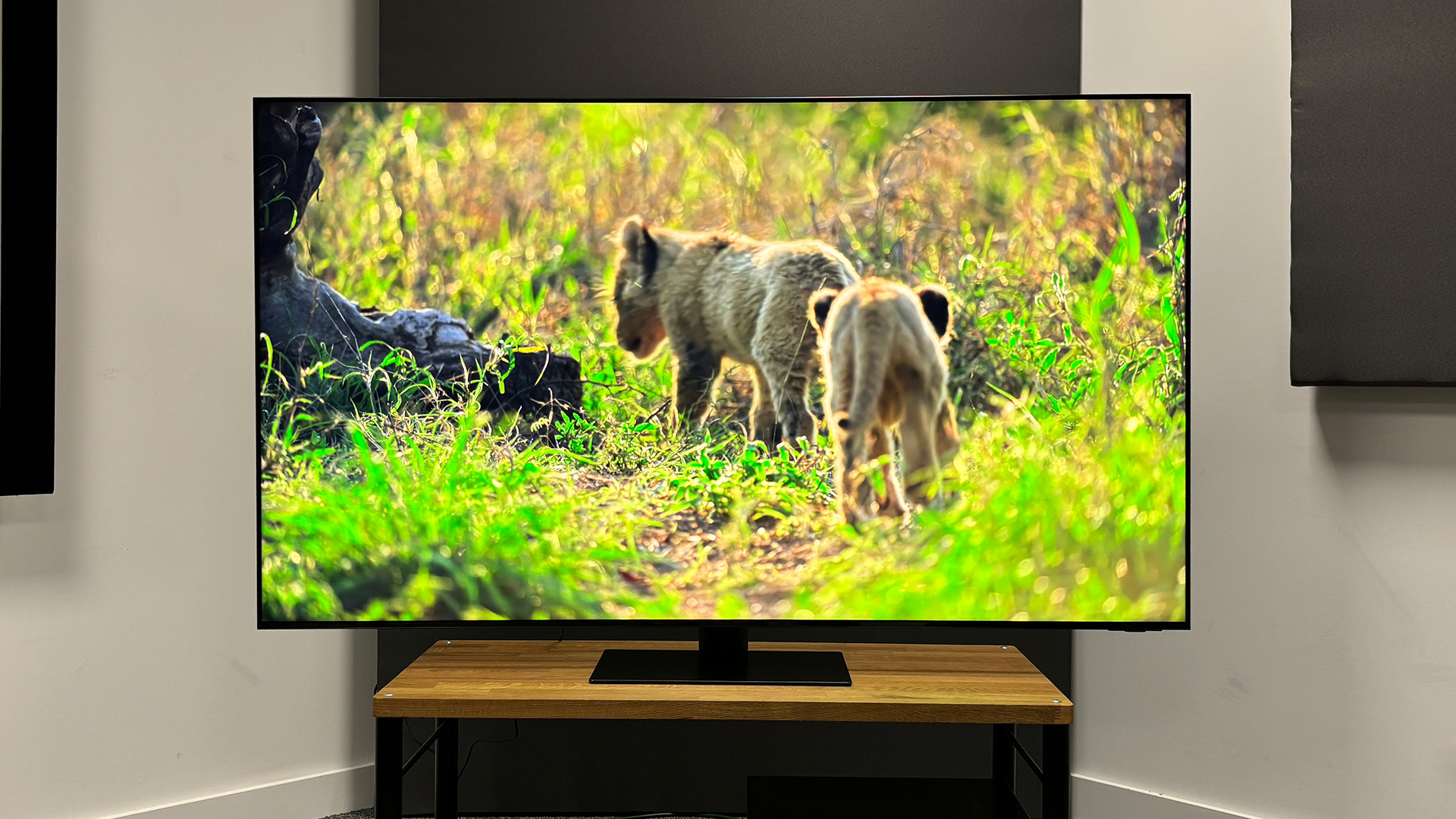
The Samsung QN95D gets quite a lot right in the picture department. It’s bright, crisp and fairly well-balanced – the only problem is that we have it set up side by side with a 65-inch S95D, which has the unfortunate tendency of highlighting its Mini LED counterparts’ deficiencies. We’ve connected the Panasonic DP-UB820EB and raided our 4K Blu-ray shelf for some of our usual favourite test discs, including Oppenheimer, Blade Runner 2049 and Pan. We also reach for some 1080p (True Grit on Blu-ray) and standard definition (Three Billboards Outside Ebbing, Missouri) content to test every facet of this TV’s picture quality.
The QN95D makes a strong first impression, as it’s immediately clear that this TV is brighter than its QD-OLED cousin. Even just opening the Blu-ray disc menu for Oppenheimer shows this, and when we hit play, we find that to be the case throughout the film. Outdoor scenes look vibrant and punchy, but not in an unnatural sense, while bursts of sun through windows make characters’ faces shine.
We watch segments of Oppenheimer in both Filmmaker and Movie mode, which leads us to an interesting realisation: while Filmmaker is undoubtedly the more accurate of the two, we find Movie to be the more enjoyable picture preset thanks to its slightly heightened brightness and contrast. Both modes offer well-balanced colours (although there is certainly more subtle variation in the S95D) and motion isn’t an issue with either.
Skin tones look well-judged too, with a lively glow to practically every actor’s face that doesn’t cross the boundary of looking overtly orange – something of which some previous Samsung TVs have been guilty. Colours still appear vivid and engaging overall, but we certainly approve of Samsung reining in its occasional overexuberance. Pair this with a crisp, well-defined picture that captures the finer details in both skin and environmental textures, and it has to be said that this TV can be really enjoyable to watch with scenes that lend themselves to its bright and sharp delivery.
We also quickly try Pan, an immensely bright film that’s mastered at 4000 nits, to push the Mini LED set to its limits. The enhanced brightness of the QN95D adds a vivid and captivating flair to the image, and while its in-house S95D QD-OLED rival puts up a good performance thanks to its brightness-boosting quantum dot technology, it can’t quite live up to the Mini LED if we’re strictly talking about brightness.
Switching back to Oppenheimer, the QN95D demonstrates another area in which it pulls ahead of the S95D – shadow detail. Finer textural details and patterns in dark suits seem to get a touch lost on the QD-OLED model, while the QN95D manages to not only retain them but also deliver them with suitable definition. Lapels and stripes of dark suit jackets occasionally sink into a wholly dark mass on the S95D but remain distinguishable with plenty of detail on the Neo-QLED.
It’s not all good news for the QN95D, though, as there are some notable oddities and downright deficiencies to its pictures that are an issue in isolation and become more apparent when watching the same content on the S95D. The first is a peculiar blue halo effect around particularly bright objects that seems to happen in certain scenes. During a black-and-white segment in Oppenheimer in which a committee meets at a restaurant, there is a subtle but offputting blue tint to the whole image.
This is most noticeable in the wall-mounted candelabras and overhead lights, which are plagued by a distracting blue aura – and this is with the TV in its ‘Warm 2′ Colour Temperature setting’.
The black and white portion of this film looks much better on the S95D, with a richer, more sepia-toned white to the image. This makes it look considerably more authentic and it’s overall a lot more pleasant on the eyes. The S95D also looks more three-dimensional and impactful with almost all of the content we watch, thanks primarily to its better handling of contrast.

We also need to discuss blooming. We use a scene later in the film in which the strip of land leading up to the testing site is illuminated with spotlights. This scene takes place at night, and thanks to the S95D’s OLED panel with its pixel-perfect light control, it looks very effective. The Mini LED-powered QN95D, on the other hand, does not get the same commendation. This shot looks frankly woeful on this TV, with big, blotchy light halos surrounding each of the spotlights, as well as a smudgy navy tinge to the rest of the picture that clouds the remaining part of the dark scene. Tweaking the local dimming and Contrast Enhancer settings doesn’t rectify things to a satisfying degree.
Moving onto some 1080p content with True Grit on Blu-ray, and we’re back to a more positive outlook for the QN95D. The movie looks great on this TV, with excellent clarity and rich colours. The TV seems to have no problems displaying content at a lower resolution, as everything from skin textures to the sandy ground of the Western town looks sharp.
Switching to an even lower resolution, we watch a segment of Three Billboards Outside Ebbing, Missouri on DVD and things get a bit more muddled. As to be expected it’s somewhat of a mixed bag; edges of objects and characters look a touch soft, foliage can look blocky and colours are lacking in subtlety. That being said, the QN95D retains some important detail, especially in faces, which look clear and retain some skin detail.
Sound
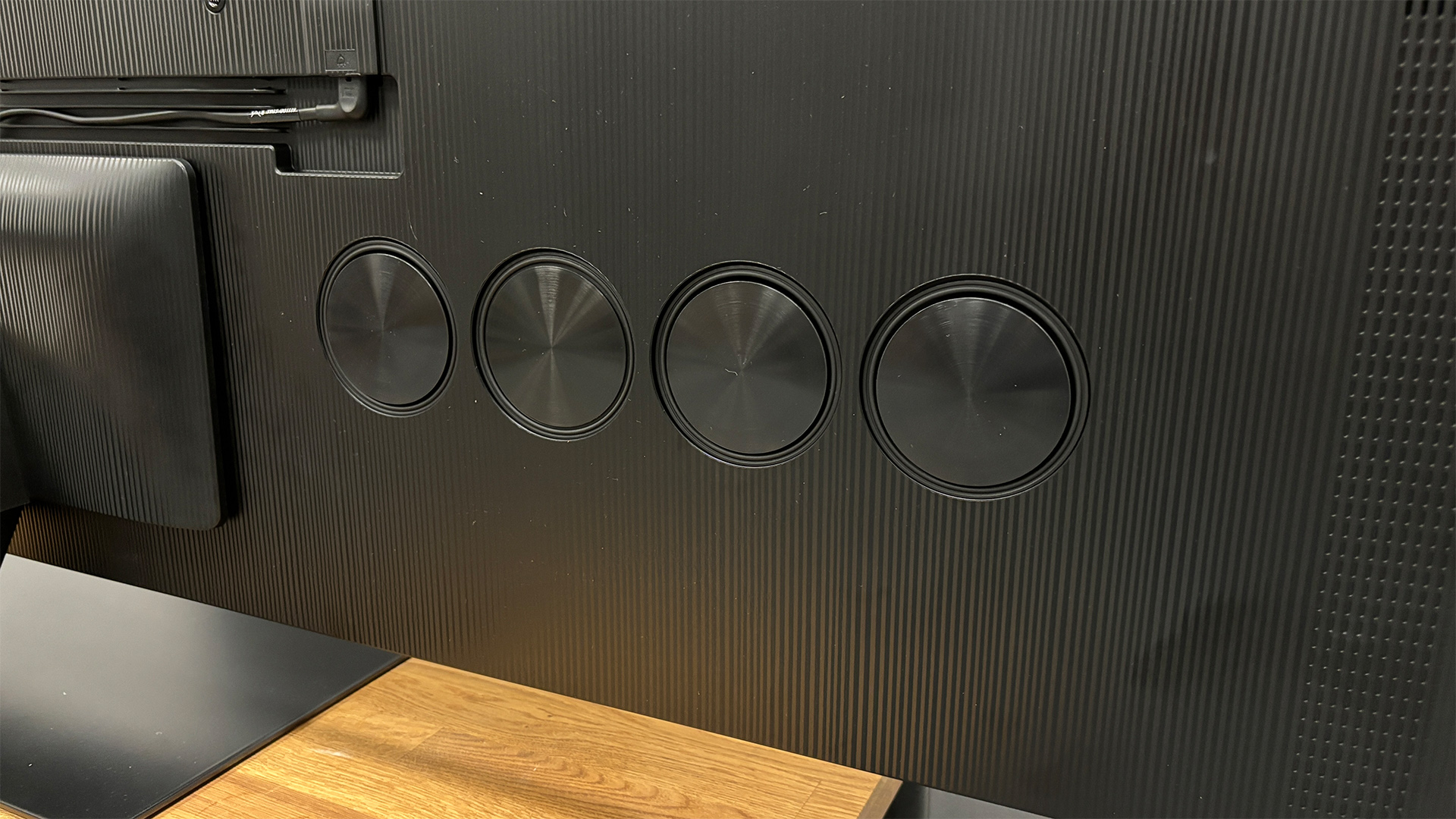
We’re using our trusty Blade Runner 2049 disc to test sound, as it features an infamously tricky scene with lots of bass and atmospheric warbling sounds. The Flight To The LAPD track that plays as Officer K returns to his base in the dystopian metropolis is lacking in weight from the QN95D, and while the higher frequencies sound fine, the bass response is very underwhelming.
Furthermore, the TV does not project sound into the room to a great extent, nor does it make any great attempt to impress where dynamics are concerned. It does, however, extend the sound quite well vertically, making the soundtrack and dialogue feel a bit more spacious.
On the subject of dialogue, speech is clear and easy to understand, even if the built-in sound system doesn’t provide much in the way of low-level dynamics, so we miss some of the finer details in the actors’ delivery of dialogue.
We switch the TV to Amplify Mode in the sound settings, which does help in some ways. The sound seems to open up slightly and it projects further too, but it severely impacts bass as a result. The deep, warbling bassline seems to completely lose timing with the rest of the track, to the extent that it sounds rather unpleasant. As per our usual advice, we’d recommend a Dolby Atmos soundbar if you want quality home cinema sound.
Verdict
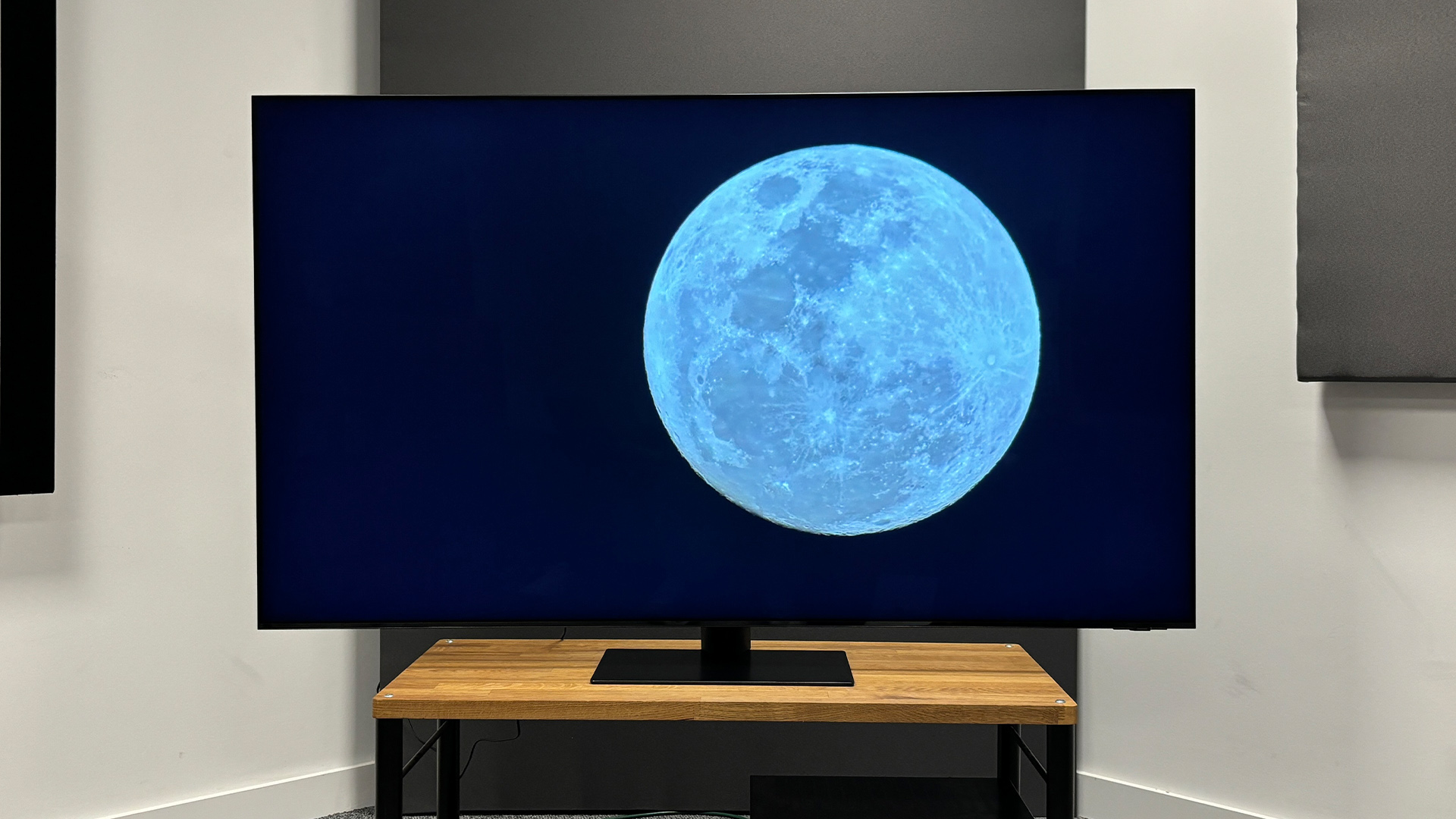
Samsung’s pricey Neo-QLED impresses in a variety of ways. Its sharp and engaging picture gets a lot right, while its feature set is difficult to pick flaws in – especially for hardcore console gamers. Its punchy and vibrant brightness does a lot of heavy lifting too, creating dazzling highlights and digging out dark details that its QD-OLED counterpart seems to miss.
Unfortunately, a handful of factors hold it back from true greatness: distracting visual oddities and a middling sound system are frustrating, and the blooming effect found in particularly dark scenes is very disappointing.
There is also the S95D, which lurks uncomfortably close on price and with its glorious QD-OLED panel produces a deeper, richer and more cinematic picture overall. While it may not go quite as bright, the S95D’s sensational handling of contrast means that it will be the better buy for most people.
SCORES
- Picture 4
- Sound 3
- Features 5
MORE:
Read our review of the Samsung S95D
Also consider the TCL C845K
Read our LG C4
Best TVs: flagship OLEDs and affordable flatscreens tried and tested
->Google Actualités










